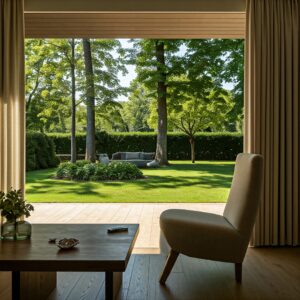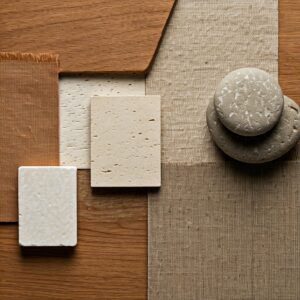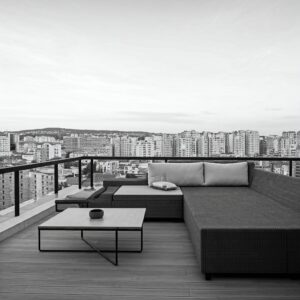
Bringing the Outdoors In: Transform Your Home with Nature’s Touch

The fast-paced, technologically driven world of today has caused many of us to lose touch with nature. Today’s average person spends an astounding 93% of their time indoors, frequently in confined spaces like shopping malls, businesses, and schools. Even if a beach vacation or weekend trek might offer much-needed relaxation, what if we could enjoy the same healing qualities of nature in the comfort of our own homes?We will go over seven essential biophilic design concepts in this extensive tutorial to help you better incorporate nature into your house.
The idea of biophilic design is relevant in this situation. Renowned biologist Edward O. Wilson first used the term “biophilia” to describe the natural human inclination to look for relationships with other living systems and natural processes. When applied to the built environment, biophilic design seeks to enhance our interaction with nature so that we can benefit from its mental, emotional, and physical benefits.These techniques will turn your living area into a true haven that effortlessly blends indoor and outdoor spaces, from utilizing the power of natural light and air to adding lush flora and calming water features. Let us get started!
1. Light and Air

The capacity to enjoy natural light and air in the house is one of the most basic components of biophilic design. Seasons, the ever-present movement of the elements, and the ebb and flow of daylight all have a profound impact on our circadian rhythms and general well-being.
Prioritize using skylights and movable windows that let you interact directly with the outdoors in order to strengthen this bond. Imagine sitting in the comfort of your own living room and watching the clouds pass by, feeling the soft air, and smelling the rain. In addition to improving your sensory experience, this dynamic interaction between the inside and outside of your body aids in regulating your body’s natural sleep-wake cycle.
2. Vegetation

Vegetation is the heart of biophilic design if light and air are its lungs. One of the best ways to incorporate nature into your house is to have a lot of plants, both indoors and out. According to studies, having greenery around us can significantly improve our mental and physical health by lowering stress levels, enhancing air quality, and even increasing productivity.
Do not limit yourself to a few token houseplants when choosing your plant palette. Create landscapes that are lush and complex to resemble the natural environment. Building an indoor atrium, growing a living green wall, or even adding a native green roof might all be part of this. In addition to enjoying the natural beauty, you can help local species and ecosystems by encircling yourself with a wide variety of plants.
3. Water

Another essential component of biophilic architecture is the calming influence of water. The experience of water may stimulate all of our senses, reducing tension and fostering a sense of peace, whether it is the soft trickle of a fountain, the captivating flow of a stream, or the serene reflection of a pond.
There are many inventive methods to include water elements on a smaller scale, even though large water features might not be practical for every home. Think about adding a recirculating water wall, setting up a tabletop fountain, or even arranging your living area to benefit from views of a local lake or river. The secret is to establish a balance between the natural and constructed worlds so that the soothing influence of water permeates every aspect of your existence.
Milanote, Your Creative Workspace
I want to take a moment to introduce Milanote before we continue our exploration of the fundamentals of biophilic design. Your biophilic design plans and other creative endeavors can be better organized and visualized with the aid of Milanote, a robust web application.
Imagine having a digital workstation that resembles the creative studios you have seen, complete with checklists, diagrams, mood boards, and inspiration photos. Milanote provides just that, enabling you to easily gather, organize, and distribute your thoughts while you strive to incorporate nature into your house.
Whether you’re curating a mood board for your color palette, mapping out the layout of your indoor garden, or collaborating with designers and contractors, Milanote’s intuitive interface and extensive template library make the process a breeze.
4. Natural Materials and Colors

The use of natural materials and colors to create a stronger bond with nature is another aspect of biophilic design, in addition to the sensory experiences of light, air, vegetation, and water.
In your furniture, finishes, and décor, embrace the coziness and feel of natural materials like wood, stone, and natural fibers. These components serve to create a calm, calming ambiance in addition to giving your room a feeling of authenticity and timeless appeal. Steer clear of excessively artificial or manufactured materials, as they may interfere with the natural flow between the interior and outdoor spaces.
When it comes to your color palette, take inspiration from the earthy tones and muted hues found in nature. Subdued browns, greens, and blues will help to foster a sense of calm and tranquility, while vibrant, saturated colors can feel jarring and disruptive to the biophilic experience. By carefully curating your material and color choices, you can craft a living environment that truly resonates with the natural world.
5. Patina of Time

Biophilic design welcomes the aging and weathering process, which contrasts with the clean, well-kept look frequently connected to modern architecture. The materials and finishes used in your home should be given the opportunity to create a distinctive pattern, much like how the elements gradually mold and change the natural landscape.
Instead of aiming for an immaculate, unaltered look, think about using materials and methods that will naturally change over time. This can entail accepting the minor flaws in handcrafted furniture or letting your outside timber veneer weather and age. You may create a living, breathing space that seems incredibly connected to the surrounding natural cycles by embracing the patina of time.
6. Outdoor Space

Blending indoor and outdoor living areas is one of the best ways to incorporate biophilic design into your house. You can increase your living space while strengthening your bond with the land by reducing the disturbance to the natural environment and designing useful outdoor spaces.
A lower overall footprint will allow for more space for courtyards, gardens, and other green areas when designing the layout of your house. As extensions of your interior, these transitional areas can offer chances for leisure, enjoyment, and even food production. To guarantee a smooth, seamless transition between the constructed and natural worlds, give careful thought to where windows, doors, and other architectural components are placed.
7. Relationship to Place

The last biophilic design principle highlights how important it is to have a close relationship between your house and the surrounding environment. It is important to take into account the distinct ecological, cultural, and climatic variables that define your particular site rather than just copying design elements from other areas.
This entails taking influence from traditional building methods and architectural styles, utilizing locally obtained materials, and integrating native plant species. You may assist the local ecology and community while also creating a more genuine and meaningful living place by integrating your home with the unique character of its surroundings.
For example, a Japanese-inspired home would feel deeply out of place in the Australian Outback, just as a Scandinavian-style dwelling would seem incongruous in the tropics. By embracing the genius loci, or “spirit of the place,” you’ll cultivate a profound sense of belonging and stewardship that extends far beyond the walls of your home.
Bringing it All Together
As we have seen, the ideas behind biophilic design provide a comprehensive strategy for incorporating nature into our homes and creating a stronger, more meaningful bond with the natural world. We can create healing, life-affirming spaces that nourish our bodies and souls by utilizing the power of light and air, adding lush greenery, and adding calming water components.
The use of natural materials and colors, the appreciation of time’s patina, the smooth transition between indoor and outdoor areas, and a profound regard for the distinctive qualities of the local environment are all highlights of biophilic design in addition to the sensory pleasures. We can create havens in our houses that genuinely embody our natural biophilic inclinations by combining these components.
So, whether you’re planning a new build, renovating an existing space, or simply looking to infuse more nature into your daily life, I encourage you to embrace the principles of biophilic design. With the help of tools like Milanote, you can start visualizing and organizing your ideas, bringing your vision of a harmonious, nature-centric home to life.
Follow https://www.digitalpluto.co.in/ for more latest updates about graphic design.






